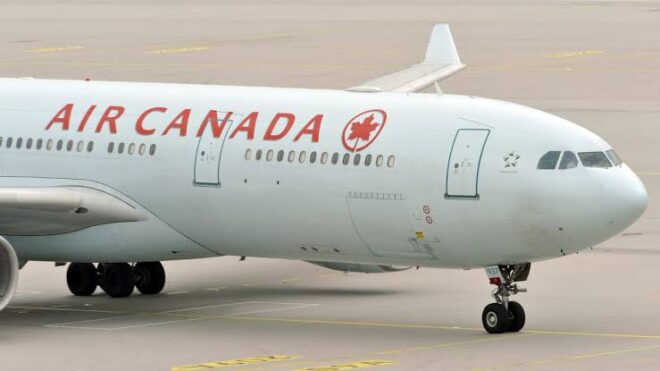
In what was likely a tense few moments for everyone on board, an Air Canada flight bound for Newark, New Jersey, was forced to turn back to Halifax Stanfield International Airport Thursday morning due to a reported tire issue. The flight, operated by Provincial Airlines (PAL) and carrying the flight numbers PVL2267 and AC2267, declared an emergency shortly after takeoff.
Just after departure, the aircraft encountered an issue that led the flight crew to request an emergency return. The plane communicated with Halifax’s air traffic control to notify them of a technical concern, though details were not immediately shared beyond the initial emergency declaration. According to a statement from the Halifax Airport Authority, “Shortly after take-off, an Air Canada Halifax–Newark flight operated by Provincial Airlines declared an emergency and requested to return to Halifax Stanfield International Airport.”
The response was swift and comprehensive. Halifax Stanfield’s Emergency Response Services (ERS) team was notified immediately following the emergency call and began preparations to address any safety concerns upon the aircraft’s return. Runway teams were on high alert, ready with necessary equipment to assist in case of a hard landing or further mechanical issues. This team regularly trains to handle emergency situations, ensuring they were prepared to respond immediately if required.
After a short time in the air, the aircraft returned and landed safely. Observers at the airport and some passengers onboard noted the situation appeared controlled but understandably tense. As soon as the plane touched down, the ERS team inspected the aircraft directly on the runway.
After assessing the situation upon landing, the emergency team determined that the aircraft did not require immediate towing. While the exact details of the inspection are still undisclosed, the plane was deemed safe to taxi back to the terminal under its own power, allowing for a routine and orderly disembarkation process for passengers.
Passengers were understandably shaken, but the uneventful return to the terminal indicated that the issue did not escalate to a severe or hazardous level. “The ERS team inspected the aircraft upon arrival on the runway, and it was determined that the aircraft could taxi on its own back to the terminal building to deplane the passengers on board,” Halifax Airport Authority’s statement elaborated.
Following the landing, rumors began circulating on social media suggesting that one of the plane’s wheels had caught fire. However, Joe Galimberti, a spokesperson for PAL Airlines, addressed these reports in a statement, emphasizing that while a technical issue was detected, reports of a fire were unconfirmed. Instead, PAL Airlines verified that they had received a report indicating “a potential issue with one of the aircraft’s tires,” which necessitated the precautionary measures taken.
PAL Airlines and Halifax Airport Authority have yet to confirm any specifics regarding the nature of the tire issue, but the prompt response suggests that it was considered significant enough to warrant an immediate return to Halifax.
According to sources at the airport, the flight initially took off in the mid-morning hours and subsequently declared an emergency shortly after. The aircraft turned back to Halifax around 11:35 a.m., local time. Within minutes, it was back on the runway and under inspection by emergency response teams. The disembarkation process took place smoothly following a quick check of the aircraft’s systems and condition.
By midday, the majority of passengers were back inside Halifax Stanfield Airport, where they were quickly assisted with rebooking and alternative travel arrangements. “The passengers onboard are now being rebooked,” confirmed Galimberti, adding that passenger care was being prioritized by both Air Canada and PAL Airlines in light of the situation.
The incident highlights the rigorous safety protocols in place for both Air Canada and PAL Airlines, as well as Halifax Stanfield International Airport’s commitment to responding efficiently to unexpected in-air situations. Aircraft tires are essential for safe takeoffs and landings, enduring intense stress under the weight of fully-loaded planes and extreme pressure on impact with runways. Issues with aircraft tires are rare but can occur due to various factors, including temperature fluctuations, wear and tear, or debris on the runway.
Federal regulations require that pilots, co-pilots, and maintenance teams conduct regular pre-flight inspections of aircraft, including the tires. Despite these checks, issues can sometimes develop after takeoff, prompting the flight crew to make real-time safety decisions. In this case, the pilots’ quick action to return to Halifax and land safely underlines the importance of these protocols.
For passengers, the return and unexpected delay were unsettling, with many expressing concern but relief that the issue was caught early and resolved without incident. While delays and emergencies can disrupt travel plans, airlines make passenger safety their top priority, even if it means revising flight schedules. As of Thursday afternoon, both Air Canada and PAL Airlines had arranged alternative flights or accommodations for affected passengers, assuring that they would reach their destinations as quickly as possible.
Although the incident did not result in any injuries or major disruptions, PAL Airlines will likely conduct a comprehensive post-incident investigation to determine the cause of the reported tire issue. The incident may also lead to enhanced inspection procedures to avoid similar issues in the future. Meanwhile, Halifax Stanfield International Airport continues to uphold its safety commitments, having managed the emergency smoothly and efficiently.
The emergency response showcases Halifax Stanfield’s readiness and the airlines’ commitment to passenger safety, ensuring that a minor issue was managed before it could escalate. Although such incidents can be nerve-wracking, the prompt response and careful management offer reassurance to travelers, underscoring the resilience and preparedness of Canada’s aviation system.